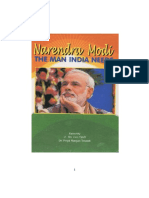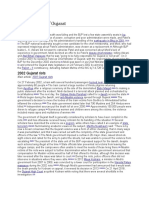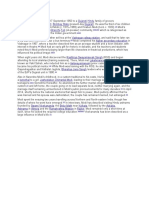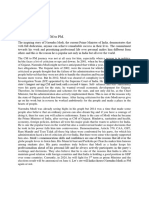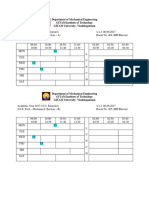Pronunciation Help Info Chief Minister of Gujarat Bharatiya Janata Party
Pronunciation Help Info Chief Minister of Gujarat Bharatiya Janata Party
Uploaded by
Sagar V. ThakkarCopyright:
Available Formats
Pronunciation Help Info Chief Minister of Gujarat Bharatiya Janata Party
Pronunciation Help Info Chief Minister of Gujarat Bharatiya Janata Party
Uploaded by
Sagar V. ThakkarOriginal Title
Copyright
Available Formats
Share this document
Did you find this document useful?
Is this content inappropriate?
Copyright:
Available Formats
Pronunciation Help Info Chief Minister of Gujarat Bharatiya Janata Party
Pronunciation Help Info Chief Minister of Gujarat Bharatiya Janata Party
Uploaded by
Sagar V. ThakkarCopyright:
Available Formats
Narendra Modi Narendra Damodardas Modi ( pronunciation (helpinfo); born 17 September 1950) is the 14th and current Chief
Minister of Gujarat, a state in western India, representing the Bharatiya Janata Party (BJP). Modi was a key strategist for the BJP in the successful 1995 and 1998 Gujarat state election campaigns. He first became chief minister of Gujarat in October 2001, being promoted to the office upon the resignation of his predecessor, Keshubhai Patel, following the defeat of BJP in by-elections. In July 2007, he became the longest-serving Chief Minister in Gujarat's history when he had been in power for 2,063 days continuously. He is currently into his fourth consecutive term as Chief Minister. Modi is a member of the Rashtriya Swayamsevak Sangh (RSS) and is described as a Hindu nationalist by scholars and himself.[1][2][3] Modi is a controversial figure both within India and internationally.[4][5][6][7] While his administration has been criticised for the incidents surrounding the 2002 Gujarat violence,[7][8] he has also been praised for his economic policies which are credited with creating the environment for the high economic growth in Gujarat.[9] Early life and education Modi was born on 17 September 1950[10] to a family of grocers in Vadnagar in Mehsana district of what was then Bombay State (presentday Gujarat), India.[11] He was the third of six children born to Damodardas Mulchand Modi and his wife, Heeraben.[12][13] While a teenager, Modi ran a tea stall with his brother around a bus terminus.[14] He completed his schooling in Vadnagar, where a teacher described him as being an average student but a keen debater.[13] He began work in the staff canteen of Gujarat State Road Transport Corporation (GSRTC), where he stayed till he became a fulltime
pracharak (propagator) of the RSS.[13][15] After Modi had received some RSS training in Nagpur, which was a prerequisite for taking up an official position in the Sangh Parivar, he was given charge of Sangh's student wing, Akhil Bharatiya Vidyarthi Parishad (ABVP), in Gujarat. Modi organised agitations and covert distribution of Sangh's pamphlets during the Emergency.[13] During his years in the RSS, Modi came in touch with Vasant Gajendragadkar and Nathalal Jaghda, leaders of the Jan Sangh, who later founded the BJP's Gujarat state unit.[15] Modi remained a pracharak in the RSS while he completed his Master's degree in political science from Gujarat University.[16] Early political career The RSS seconded Modi to the BJP in 1987.[15][17] While Shankarsingh Vaghela and Keshubhai Patel were the established names in the BJP, Modi rose to prominence after organising Murli Manohar Joshi's Ekta yatra (journey for unity).[13] His electoral strategy was central to BJP's victory in the 1995 state elections.[15][17][18] Modi became the General Secretary of the BJP and was transferred to New Delhi where he was assigned responsibility for the party's activities in Haryana and Himachal Pradesh.[17] Vaghela, who had threatened to break away from BJP in 1995, defected from the BJP after he lost the 1996 Lok Sabha elections. In 1998, Modi was promoted to the post of National Secretary of the BJP.[13] While selecting candidates for the 1998 state elections in Gujarat, Modi sidelined people who were loyal to Vaghela and rewarded those who favoured Patel, thus ending factional divisions within the party. His strategies were key to winning those elections.[17]
Chief Minister of Gujarat First Term (2001-2002) Patel's failing health, along with allegations of abuse of power, corruption and poor administration, as well as a loss of BJP seats in by-elections and the effects of the devastating Bhuj Earthquake of 2001, which his administration struggled to handle, prompted the BJP's national leadership to seek a new candidate for the office of chief minister.[17][19][20] Modi, who had aired his misgivings about Patel's administration, was chosen as a replacement.[13] L. K. Advani, a senior leader of the BJP, however, did not want to ostracise Patel and was worried about Modi's lack of experience in governance. It was suggested that Modi should be made the deputy chief minister in a government led by Patel. Modi informed Advani and Atal Bihari Vajpayee that he was "going to be fully responsible for Gujarat or not at all" and declined the proposal. On 7 October 2001, Modi was appointed the Chief Minister of Gujarat and was assigned responsibility to prepare the BJP for elections in December 2002.[19] As Chief Minister, Modi's ideas of governance revolved around privatisation and small government, which stood at odds with what Aditi Phadnis has described as the "antiprivatisation, antiglobalisation position" of the RSS.[19] 2002 Gujarat violence Main article: 2002 Gujarat violence In 2002, there was widespread Anti-Muslim violence throughout Gujarat after reports that a crowd of Muslims had attacked a train carrying mostly Hindu Pilgrims and set it on fire near Godhra railway station burning alive many of the paasengers.[21] The Gujarat administration was accused by the opposition and sections of the media of taking insufficient action against the violence, and even condoning it in some cases.[22][23][24] The Modi government had imposed curfews, issued shoot-at-sight orders and
called for the army to prevent the violence from worsening but the combined strength of the army and state police proved insufficient.[23][24] In April 2009, the Supreme Court of India appointed a Special Investigation Team (SIT) to inquire into the Gujarat government and Narendra Modi's role in the incidents of communal violence.[22] The SIT reported to the court in December 2010 submitting that they did not find any incriminating evidence against Modi of willfully allowing communal violence in the state.[25] Modi's decision to move the corpses of the kar sevaks who had been burned to death in Godhra to Ahmedabad had been criticised for inflaming the violence.[26][27] However, the SIT found his decision to be justified.[28] In April 2012, the SIT absolved Modi of any involvement in the Gulbarg Society massacre that occurred in 2002.[29][30] On 7 May 2012, the Supreme Court-appointed amicus curiae, Raju Ramachandran, observed that Modi could be prosecuted for promoting enmity among different groups during the 2002 Gujarat violence. His main contention was that the evidence should be examined by a court of law because the SIT was required to investigate but not to judge.[31] The amicus report has been criticised by the Special Investigation Team for relying heavily on the testimony of Sanjiv Bhatt.[32] In July 2013, Zakia Jaffri, widow of Ehsan Jafri, alleged that the SIT was suppressing evidence.[33] 2002 election Main article: Gujarat legislative assembly election, 2002 In the aftermath of the violence, there were calls for Modi to resign from his position as chief minister of Gujarat. The opposition parties stalled the national parliament over the issue. Both the Dravida Munnetra Kazhagam (DMK) and the Telugu Desam Party (TDP), allies of the BJP, also asked for Modi's resignation, as did Jayalalithaa, the then-Chief Minister of
Tamil Nadu and leader of the All India Anna Dravida Munnetra Kazhagam (AIADMK).[34][35] Modi submitted his resignation and the state Assembly was dissolved.[36] In the resultant elections the BJP, led by Modi, won 127 seats in the 182-member assembly.[37] Modi used extreme anti-Muslim rhetoric during the campaign.[38][39][40] Second term (20022007) During his second term, Modi's emphasis shifted from Hindutva to the economic development of Gujarat.[19] Modi's decisions curtailed the influence of organizations of the Sangh Parivar such as the Bharatiya Kisan Sangh (BKS) and Vishva Hindu Parishad (VHP),[41] which had become entrenched in Gujarat after the decline of Ahmedabad's textile industry.[19] Modi dropped Gordhan Zadaphia, an ally of his former Sangh coworker and VHP state chief Praveen Togadia, from the cabinet ministry. When BKS launched a farmers' agitation, Modi ordered their eviction from houses provided by the state government.[41] Modi's decision to demolish 200 illegal temples in Gandhinagar deepened the rift with VHP.[41][42] Various organisations of the Sangh were no longer consulted or apprised of Modi's administrative decisions prior to enactment.[41] Between 20022007, Gujarat emerged as an attractive investment destination. Aditi Phadnis, author of Political Profiles of Cabals & Kings and columnist in the Business Standard, writes that "there was sufficient anecdotal evidence pointing to the fact that corruption had gone down significantly in the state... if there was to be any corruption, Modi had to know about it".[19] Modi instituted financial and technology parks in the state. During the 2007 Vibrant Gujarat summit, real estate investment deals worth 6.6 trillion (short scale) ( 6600 billion) were signed in Gujarat.[19] In 2003, when Narendra Modi was asked about the conflict of
his dreams for Gujarat's future with international criticism of his past activities, Modi said,[43] Yet, no one has asked this question to the USA after 9/11. Delhi is developing fast no one has asked this question to Delhi after 1984. If it does not matter to Delhi and USA, why should it matter to Gujarat? Atal Bihari Vajpayee, then Prime Minister of India, who had asked Modi not to discriminate between citizens in the aftermath of the 2002 Gujarat violence and had pushed for his resignation as Chief Minister of Gujarat,[44][45] distanced himself from Modi and reached out to North Indian Muslims before the 2004 elections to the Lok Sabha. After the elections, Vajpayee held the violence in Gujarat as one of the reasons for BJP's electoral defeat and acknowledged that not removing Modi immediately after the Gujarat violence was a mistake.[46][47] Modi had attempted to equate the Gujarat violence with the events of 9/11 in the USA and responded to a newspaper's criticism that compared him to Hitler, Pol Pot and Slobodan Milosovic by saying that "I have not read and I would not like to read [the criticism]. But thank you people for spending time on me."[43] Terrorism and elections in 20072008 Further information: Gujarat legislative assembly election, 2007 In the lead up to assembly and general elections in 20072008, the BJP stepped up its rhetoric on terrorism.[48] On 18 July 2006, Modi criticised the Indian Prime Minister, Manmohan Singh, "... for his reluctance to revive anti-terror legislations" such as the Prevention of Terrorist Activities Act. He asked the national government to allow states to invoke tougher laws in the wake of the 2006 blasts in Mumbai.[49] Modi said that:
Terrorism is worse than a war. A terrorist has no rules. A terrorist decides when, how, where and whom to kill. India has lost more people in terror attacks than in its wars.[49] Around this time Modi frequently demanded the execution of Afzal Guru,[50] a collaborator of the Pakistani jihadists who had been convicted of terrorism for his involvement in the 2001 Indian Parliament attack.[51][a] Modi had completed 2,063 consecutive days as chief minister of Gujarat in July 2007, making him the longest-serving holder of that post.[52] The BJP won the 2007 election, gaining 122 of the 182 seats in the state assembly, and Modi continued in office as chief minister.[53] As a consequence of the November 2008 Mumbai attacks, Modi held a meeting to discuss security of Gujarat's 1,600 km (990 mi) long coastline which resulted in the central government authorising construction of 30 highspeed surveillance boats.[54] Third term (20072012) Gujarat is a semi-arid state and, according to Tushaar Shah, was "... never known for agrarian dynamism" but in recent years has improved its agricultural output substantially, in large part due to projects relating to improvement of groundwater supplies in Saurashtra, Kachchh and the north, as well as efforts to increase the use of micro-irrigation and to provide more efficient power supply to farms. Public irrigation measures in the central and southern areas, such as the Sardar Sarovar Project, have not been so successful in achieving their aims.[55] Development projects Successive BJP governments under Patel and Modi supported NGOs and communities in the creation of infrastructure projects for conservation of groundwater. By December 2008, 500,000 structures had been constructed, of which 113,738 were check dams. While most check dams remained empty during the pre-monsoon season, they helped recharge the
aquifers that lie beneath them.[55] 60 of the 112 Tehsils which were found to have overexploited the groundwater table in 2004 had regained their normal groundwater level by 2010[56] and Gujarat had managed to increase its groundwater levels at a time when they were falling in all other Indian states. As a result, production of genetically-modified Bt cotton, which could now be irrigated using tube wells, increased to become the largest in India.[55] The boom in cotton production and utilization of semiarid land[57] saw the agriculture growth rate of Gujarat increase to 9.6% in the period 20012007.[58] For the decade 20012010, Gujarat recorded a Compound annual growth rate of 10.97%, the highest among all Indian states.[57] The system of supplying power to rural areas has been changed radically and has had a greater impact on agriculture than the irrigation works. While states such as Andhra Pradesh and Tamil Nadu provided free electricity to farms, and most other states provided subsidised power, the Gujarat government between 20032006 reacted to concerns that such measures result in waste of the power supplied and of groundwater itself with the Jyotigram Yojana scheme, based on ideas developed by the International Water Management Institute. Agricultural supplies were rewired to separate then from other rural supplies and then the electricity used by farms was rationed to fit with scheduled demand for irrigation and consequently to reduce the amount of subsidy being paid. The farmers objected to this at first but came to realise that the outcome was that they were receiving a supply that suffered less from interruption, was of a more consistent voltage and was available when they most needed it for irrigation purposes. Other states have since begun to adopt similar, although not identical, strategies.[55]
Critique of Gujarat "miracle" Modi's government has worked to brand Gujarat as a state of dynamic development and economic growth and prosperity, using the slogan "Vibrant Gujarat".[59][60][61] However critics point out that Gujarat has a relatively poor record when it comes to human development, poverty alleviation, nutrition and education. The state is 13th in India for poverty, 21st for education and 44.7% percent of children under five are underweight and 23% are undernourished putting the state in the "alarming" category on the Hunger Index.[62] However, officials from the state of Gujarat claim that Gujarat outperformed India as a whole in the rates of improvement of multiple human indicators such as female education, between 2001 and 2011. Furthermore, they state that dropout rates declined from 20% in 2001 to 2% in 2011, and Maternal Mortality declined by 32% from 2001 to 2011[63] Political scientist Christophe Jaffrelot points out that the development in Gujarat has been limited to the urban middle class, whereas rural dwellers and lower castes have become increasingly marginalized. This is evidenced by the fact that despite the high economic growth Gujarat is only 21st in Human development index, because rural Gujaratis continue to lag behind. He claims under Modi the number of families living below the poverty line has increased, and that particularly rural adivasi and dalits have become increasingly marginalized.[64] In July 2013, Economics Nobel Laureate Amartya Sen criticized Narendra Modi's governance record and said he did not approve of it, under his administration, Gujarat's "record in education and healthcare is pretty bad".[65] However, economists Arvind Panagariya and Jagdish Bhagwati note that Gujarat's social indicator improved from a much lower baseline than other Indian states. They point to Gujarat's superior performance in raising literacy rates when compared to other states in India and the rapid
improvement of health indicators in Gujarat as evidence that "its progress has not been poor by any means."[66] Cabinet issues In 2010 Modi made a speech at Mangrol in which he justified the extrajudicial killing of Sohrabuddin Sheikh, during the election campaign in response to Sonia Gandhi's speech calling him a "merchant of death",[67] and referred to Sohrabuddin's killing. For this speech the Election Commission of India, a constitutional body governing election proceedings in India, cautioned Modi as it considered it as indulging in an activity which may aggravate existing differences between different communities.[68] In 2010 Amit Shah, Modi's close confidant and Home minister in his government was indicted for having ordered the killing of Sohrabuddin and two others, after spending three months in jail he was released on bail, and subsequently relected in one of Ahmedadbad's constituencies.[64][69] In 2012 Maya Kodnani another of Modi's former minister's from 2007 - 2009 was convicted of having participated in the Naroda Patiya massacre during the 2002 violence.[70][71] She is the first female and first MLA to be convicted in a post-Godhra riots case.[72] While first announcing that it would seek the death penalty for Kodnani, Modi's government eventually pardoned her in 2013 and settled for a prison sentence.[73][74][75] Sadbhavana Mission and Fasts During late 2011 and early 2012, Modi undertook a series of fasts as part of a Sadbhavna Mission (Goodwill Mission), meant to reach out to the Muslim community in Gujarat.[76] Modi announced that he believed that his fast would "further strengthen Gujarats environment of peace, unity and harmony."[77] The mission started on 17 September 2011 in Ahmedabad with a threeday fast aimed at strengthening the atmosphere of peace, unity, and
harmony in the state. He observed 36 fasts in 26 districts and 8 cities.[78] Some Muslims were unimpressed with his fasts, and one incident in which Modi refused to wear a skull cap offered to him by a Muslim cleric attracted widespread criticism in the media.[79] When he was fasting in Godhra, the site of the train burning that sparked the 2002 riots, a number of activists were detained for allegedly planning rallies against Modi.[80][81] Others criticized his fast as a PR mission.[82] Modi himself denied that the mission was about wooing "any particular community or religion".[83] Legislation and appointments In 2011, the Gujarat state organisation of Congress banned the Gujaratilanguage TV 9 television channel from covering its events and prohibited access to its press conferences.[84] Modi criticised this decision, saying that Journalists on Twitter who spoke against Congress, were blocked. Here they banned a TV channel. Their crime is that they exposed cracks in the ghar nu ghar (own your home) scheme of the Congress. Yet this party talks about democracy.[85] On 25 August 2011, the Governor of Gujarat, Kamla Beniwal, appointed Justice R. A. Mehta to the post of Lokayukta of Gujarat, a critical anti corruption post that had been lying vacant since 2003. Mehta was recommended for the post by the Chief Justice of the Gujarat High Court in June 2011.[86] Beniwal made this decision without consultation with and approval from Modi and his council of ministers.[87] This marked the beginning of a strained relationship between Modi and Beniwal. On 25 September 2011, Modi accused the Governor of running a parallel government in the state supported by the Indian National Congress party and demanded that she be recalled.[88]
The appointment of Mehta was challenged in the High Court by the Gujarat government. The two-member high court bench gave a split verdict on 10 October 2011. In January 2012, a third member upheld Beniwal's decision.[89] Modi has also accused Beniwal of delaying a bill for reservation of 50% of seats in local government for women.[90] Modi interacted with netizens on Google+ on 31 August 2012.[91] The chat session was also broadcast live on YouTube.[91] The questions were submitted before the chat, and those broadcast were mostly based on issues about education, youth empowerment, rural development and causes of urbanisation.[92] The hashtag #ModiHangout became the most trending term in India at Twitter on the day of the session, whereas #VoteOutModi, used by Modi's opponents, became the third most trending term in the country.[91] The event made Modi the first Indian politician to interact with netizens through live chat on the internet.[93] Fourth term (2012present) Further information: Gujarat legislative assembly election, 2012 In the 2012 Gujarat legislative assembly elections, Modi won from the constituency of Maninagar with a majority of 86,373 votes over Sanjiv Bhatt's wife, Shweta, who was contesting for the Indian National Congress.[94] The BJP as a whole won 115 of the 182 seats; it has formed the government in Gujarat since 1995[95] and has had an absolute majority throughout Modi's time in office.[96] Later in the by-elections for six seats, the BJP won all the seats in Gujarat which consisted of four assembly seats and 2 Lok Sabha seats. Interestingly, BJP won all these seats although Modi never campaigned for its candidates and all the seats were held by the Congress prior to the by-elections.[97] This brought up the number of seats held by the BJP in the state assembly to 119.
Role in central politics In March 2013, Modi was appointed as member of the BJP Parliamentary Board, its highest decision-making body, and also as a Chairman of the party's Central Election Campaign Committee.[98][99] Modi was selected to head the poll campaign for 2014 parliamentary election, at the national level executive meeting of BJP on 10 June 2012. The party's senior leader and founding member L.K. Advani resigned from all his posts at the party following the selection, protesting against leaders who were "concerned with their personal agendas"; the resignation was described by The Times of India as "a protest against Narendra Modi's elevation as the chairman of the party's election committee".[100] However, Advani withdrew his resignation the next day at the urging of RSS chief Mohan Bhagwat.[100] Uttarakhand floods controversy In June 2013, The Times of India released a story saying that Modi had commissioned Boeings, SUVs, and luxury buses to rescue 15,000 Gujarati victims of the 2013 Uttarakhand floods.[101][102] Though the newspaper later retracted the story issuing Clarification saying that Modi's government had assisted 15,000 UK Flood victims irrespective of states rather than rescuing 15,000 Gujaratis as earlier reported and The Times of India was mortified by the controversy created,[103] the story became the center of controversy with allegations that Modi was attempting to create a "Rambo" image in the minds of the Indian public.[104] The actions were widely disbelieved because of the sheer enormity of the task,[105] and also criticised for giving preferential treatment to Gujaratis over other victims and for visiting the area though the government in Uttarakhand had explicitly discouraged such visits so as to not divert attention and resources from ongoing rescue efforts.[106][107][108] BJP representatives later denied that Modi himself had ever stated that he had intervened in the rescue operation, and conceded
that perhaps BJP workers had contributed to the impression of Modi's personal involvement.[109][110] Possible prime-minister In three opinion polls conducted by news agencies and magazines, Narendra Modi was the preferred choice among Indians for the post as Prime Minister in the forthcoming parliamentary elections.[111][112][113] A C-Voter poll suggested that by projecting Modi as the Prime Minister candidate, the National Democratic Alliance (NDA) could gain a five percent increase in the vote share; it said that projecting Modi could increase NDA's seats from 179 to 220, which is 52 short of majority.[113] Commenting on the polls, Political scientist Ashutosh Varshney argued that a BJP Prime Minister was unlikely unless they were able to form broad coalitions with other parties, which so far they have not been able to do.[114] In an interview, Nobel Prize laureate economist Amartya Sen, said that he did not want Modi as a Prime Minister because he had not done enough to make minorities feel safe, and also noted that under Modi, Gujarat's record in health and education provision has been "pretty bad".[65] However, economists Jagdish Bhagwati and Arvind Panagariya stated "We are impressed by Modi's economics." [115] Spiritual leaders like Ramdev and Morari Bapu have supported Modi's Prime Ministerial candidacy.[116] International diplomacy To attract foreign investment in Gujarat during his time as chief minister, Modi has made visits to countries such as China, Singapore and Japan.[117] Modi visited China in November 2006 to study the Special Economic Zones that were planned to start in Gujarat.[118] He also visited in September 2007[119] and later in November 2011. A month after his visit of 2011, the Chinese Government released 13 diamond traders from India
who had been jailed by the Shenzhen Customs, which Modi described as being the consequence of his diplomatic efforts and statesmanship.[120][121] In 2005, Modi was denied a diplomatic visa to the United States. In addition, the B-1/B-2 visa that had previously been granted to him was also revoked, under a section of the Immigration and Nationality Act which makes any foreign government official who was responsible or "directly carried out, at any time, particularly severe violations of religious freedom" ineligible for the visa.[122] In 2011, the Karachi Chamber of Commerce & Industry, impressed with the development of Gujarat, invited Modi to visit Pakistan and address prominent business leaders. They also asked him to consider a flight between Karachi and Ahmedabad, due to the historical cultural and economic relations between the two regions of Gujarat and Sindh. Modi wishes to help Pakistan out of its power crisis, especially in Sindh, suggesting Pakistan can follow the 'Gujarat Model' in two ways Gujarat Solar Park and Kalpasar Project.[123] The United Kingdom refused to deal with Modi for a decade following the 2002 violence but lifted its diplomatic boycott in October 2012.[124] Later, in March 2013, the European Union, of which the UK is a member, also ended its boycott, saying that talking with Modi was a separate issue from that of protecting human rights and those of women.[125] In July 2013, BJP president Rajnath Singh visited the US and gave a speech urging that Modi should be given a visa to visit the country.[126][127] In response to Singh's visit, 65 Members of the Indian parliament allegedly signed a letter to US President Barack Obama requesting that the policy of denying Modi a visa be upheld.[128] However, the veracity of some of the signatures has been called into question, with Sitaram Yechury among a number of purported signatories denying that they ever signed such a petition[129]
Personality and image Modi is a vegetarian.[130] He is known for leading a frugal lifestyle and has a personal staff of three. He is known to be a workaholic and an introvert.[131] He also writes poems in Gujarati.[132] He is a crowd-puller as a speaker.[133] He wears "business suits to business meetings, instead of homespun tunics. He still lampoons the urban, English-speaking elite, but he is also honing his English skills."[22] Modi is seen as a "protector" by his supporters.[22] Modi has been labelled by the media and some articles in peer reviewed journals as a controversial, polarising, and divisive figure.[134][135][136] Awards and recognitions
Gujarat Ratna by Shri Poona Gujarati Bandhu Samaj at Ganesh Kala Krida Manch on celebration of centenary year.[137] e-Ratna award by the Computer Society of India[138] Best Chief Minister In a nationwide survey conducted in 2006 by India Today magazine, Narendra Modi was declared the Best Chief Minister in the country.[139]
Asian Winner of the fDi Personality of the Year Award for 2009 by FDi magazine.[140]
In March 2012, Modi appeared on the cover of the Asian edition of the Time magazine, one of India's few politicians to have done so.[141] His leadership was described as being strong and businesslike; one that could guide India towards honesty and efficiency.[142]
You might also like
- Narendra Modi: Life Dedicated To PoliticsDocument3 pagesNarendra Modi: Life Dedicated To PoliticsHardik SharmaNo ratings yet
- S/PV 1780 19 July 1974 Makarios Speech at The UN Security Council Denouncing The Coup of The Greek JuntaDocument24 pagesS/PV 1780 19 July 1974 Makarios Speech at The UN Security Council Denouncing The Coup of The Greek JuntaErato Kozakou Marcoullis100% (3)
- Vault House - Johnston Marklee - ArchDailyDocument10 pagesVault House - Johnston Marklee - ArchDailyAlina VoNo ratings yet
- Azucena Labor StandardsDocument39 pagesAzucena Labor Standardstwenty19 law100% (1)
- Narendra Modi - Wikipedia, The Free EncyclopediaDocument17 pagesNarendra Modi - Wikipedia, The Free EncyclopediajambudweepaNo ratings yet
- Narendra ModiDocument24 pagesNarendra ModiSubhadeep SahaNo ratings yet
- REPORT On Narendra ModiDocument22 pagesREPORT On Narendra ModiAnjum Ansh KhanNo ratings yet
- Narendra Modi 6Document1 pageNarendra Modi 6Ajay ChoudhariNo ratings yet
- Biograhy of Narendra ModiDocument23 pagesBiograhy of Narendra Modidurgesh30No ratings yet
- Narendra Damodardas ModiDocument5 pagesNarendra Damodardas ModiApoorVaChandAkNo ratings yet
- Biography & Early LifeDocument6 pagesBiography & Early LifePRATEEKSHAKYANo ratings yet
- assignmentDocument25 pagesassignmentmandaarapucollege123No ratings yet
- 2002 Election: 2002 Gujarat Legislative Assembly ElectionDocument2 pages2002 Election: 2002 Gujarat Legislative Assembly ElectionKaran ThakkarNo ratings yet
- Narendra Damodardas Modi (: Gujarati PronunciationDocument15 pagesNarendra Damodardas Modi (: Gujarati PronunciationMOHIT SINGHNo ratings yet
- Narender ModiDocument9 pagesNarender ModiQuestdownNo ratings yet
- P M ModiDocument3 pagesP M ModiSidVermaNo ratings yet
- New Narendra Modi - Final BookDocument376 pagesNew Narendra Modi - Final BookUDAYAN SHAHNo ratings yet
- Narendra ModiDocument364 pagesNarendra ModiJean Claude BalaNo ratings yet
- Narendra Modi From Wikipedia, The Free EncyclopediaDocument14 pagesNarendra Modi From Wikipedia, The Free Encyclopediaamrish_25066No ratings yet
- DataDocument62 pagesDataSADCFNo ratings yet
- Narendra Damodardas ModiDocument3 pagesNarendra Damodardas ModiChirag KoshiyaNo ratings yet
- Narendra ModiDocument44 pagesNarendra ModiSambid PradhanNo ratings yet
- Narendra Damodardas ModiDocument1 pageNarendra Damodardas ModiDevid gakharNo ratings yet
- Narendra Damodardas ModiDocument1 pageNarendra Damodardas ModiAthulKrishnaPandothayilNo ratings yet
- Narendra Modi BiographyDocument6 pagesNarendra Modi BiographyAravind AenugantiNo ratings yet
- Narendra Modi DetailsDocument48 pagesNarendra Modi Detailsnavinvsuthar3No ratings yet
- Final Years: Further InformationDocument3 pagesFinal Years: Further InformationKaran ThakkarNo ratings yet
- Narendra Modi Biography PDFDocument10 pagesNarendra Modi Biography PDFmsulgadleNo ratings yet
- Chief Minister of Gujarat: Taking OfficeDocument2 pagesChief Minister of Gujarat: Taking OfficeKaran ThakkarNo ratings yet
- MtyymDocument242 pagesMtyymUsman QurayshiNo ratings yet
- Pol ScienceDocument12 pagesPol ScienceSonal vermaNo ratings yet
- Jyotiraditya Scindia - WikipediaDocument17 pagesJyotiraditya Scindia - Wikipediasiddh tantra mahasadhana margNo ratings yet
- Narendra Modi BiographyDocument17 pagesNarendra Modi BiographyMontu Patel100% (1)
- Narendra Modi and Gujrat RiotsDocument1 pageNarendra Modi and Gujrat RiotsSuhail MohamedNo ratings yet
- The Remaking of Narendra ModiDocument8 pagesThe Remaking of Narendra ModiGarima RaghuwanshiNo ratings yet
- ModinamaDocument142 pagesModinamamehul3685No ratings yet
- Practical FDMDocument8 pagesPractical FDMGaurang TiwariNo ratings yet
- Narendra Damodardas Modi (: Help InfoDocument1 pageNarendra Damodardas Modi (: Help InfoKapil BajajNo ratings yet
- Narendra Modi Biography1Document17 pagesNarendra Modi Biography1Montu PatelNo ratings yet
- Narendra ModiDocument4 pagesNarendra Modielasu85No ratings yet
- ArchitectureDocument1 pageArchitectureKaran ThakkarNo ratings yet
- Narendra Modi Faces ChallengesDocument70 pagesNarendra Modi Faces ChallengesH Janardan PrabhuNo ratings yet
- ModiDocument1 pageModiy2nyjsvwbkNo ratings yet
- 7 April 2014 Last Updated at 10:13: MR Mod's Pictures On ThemDocument2 pages7 April 2014 Last Updated at 10:13: MR Mod's Pictures On Themphoneme79No ratings yet
- ModiDocument2 pagesModipal.subuNo ratings yet
- 51 Vol 6 EpaperDocument31 pages51 Vol 6 EpaperThesouthasian TimesNo ratings yet
- Narendra ModiDocument118 pagesNarendra ModiaaravNo ratings yet
- ModinamaDocument115 pagesModinamashreekantkhaitanNo ratings yet
- Narendra Modi InfoDocument1 pageNarendra Modi InfoAjay ChoudhariNo ratings yet
- Indira Gandhi State of Emergency Akhil Bharatiya Vidyarthi ParishadDocument1 pageIndira Gandhi State of Emergency Akhil Bharatiya Vidyarthi ParishadAshok ShettigarNo ratings yet
- Narendra Damodardas Modi (Document52 pagesNarendra Damodardas Modi (Arpit MinzNo ratings yet
- Yogi Adityanath:'Bulldozer Baba' Comes Back Stronger: PTI - Mar 25, 2022, 05.53 PM ISTDocument4 pagesYogi Adityanath:'Bulldozer Baba' Comes Back Stronger: PTI - Mar 25, 2022, 05.53 PM ISTsumits07No ratings yet
- Nirmā ("Reconstruction") Movement - After Working As A Full Time Organiser For The Organisation, He WasDocument1 pageNirmā ("Reconstruction") Movement - After Working As A Full Time Organiser For The Organisation, He WasSai Ram BachuNo ratings yet
- Narendra Damodardas Modi-Born 17 September 1950) Is TheDocument1 pageNarendra Damodardas Modi-Born 17 September 1950) Is TheKKJNo ratings yet
- MODINAMA by Madhu KishwarDocument36 pagesMODINAMA by Madhu KishwarKanwar DeepNo ratings yet
- Early Political Career: Indira Gandhi State of EmergencyDocument1 pageEarly Political Career: Indira Gandhi State of EmergencyKaran ThakkarNo ratings yet
- Amit ShahDocument9 pagesAmit ShahkaibNo ratings yet
- Modinama EbookDocument142 pagesModinama Ebookrajasekar23081981No ratings yet
- AISA Folder Modi 1 DopdfDocument2 pagesAISA Folder Modi 1 DopdfAISANo ratings yet
- New Microsoft Word DocumentDocument3 pagesNew Microsoft Word DocumentBipul SahaNo ratings yet
- 5 Factors That Helped BJP and Modi Win The ElectionDocument30 pages5 Factors That Helped BJP and Modi Win The ElectionDeepthi VenugopalNo ratings yet
- Narendra Modi - By AKGDocument108 pagesNarendra Modi - By AKGanshumangupt10609No ratings yet
- We Also Make Policy: An Insider's Account of How the Finance Ministry FunctionsFrom EverandWe Also Make Policy: An Insider's Account of How the Finance Ministry FunctionsNo ratings yet
- Momin Anas AbDocument1 pageMomin Anas AbSagar V. ThakkarNo ratings yet
- A Study On Campaigns by Modi For Growth and Development of CountryDocument55 pagesA Study On Campaigns by Modi For Growth and Development of CountrySagar V. ThakkarNo ratings yet
- Mahatma Jyotirao Govindrao PhuleDocument12 pagesMahatma Jyotirao Govindrao PhuleSagar V. ThakkarNo ratings yet
- Mahatma Jyotirao Govindrao PhuleDocument12 pagesMahatma Jyotirao Govindrao PhuleSagar V. ThakkarNo ratings yet
- BasanivasanthDocument1 pageBasanivasanthSagar V. ThakkarNo ratings yet
- Harish SDocument1 pageHarish SSagar V. ThakkarNo ratings yet
- IndexDocument1 pageIndexSagar V. ThakkarNo ratings yet
- Application Form: Academic Year Institute Course Course Year Percentage ResultDocument2 pagesApplication Form: Academic Year Institute Course Course Year Percentage ResultSagar V. ThakkarNo ratings yet
- Christmas: Christmas (Old English: Crīstesmæsse, Meaning "Christ's Mass") Is An AnnualDocument1 pageChristmas: Christmas (Old English: Crīstesmæsse, Meaning "Christ's Mass") Is An AnnualSagar V. ThakkarNo ratings yet
- Resume (Nnew)Document2 pagesResume (Nnew)Sagar V. ThakkarNo ratings yet
- Powerloom Industries in BhiwandiDocument1 pagePowerloom Industries in BhiwandiSagar V. ThakkarNo ratings yet
- Ace Computer: Quotation Description QTY Rate AmountDocument2 pagesAce Computer: Quotation Description QTY Rate AmountSagar V. ThakkarNo ratings yet
- Vdocuments - MX 3906 Renault Clio WiringDocument14 pagesVdocuments - MX 3906 Renault Clio WiringMichael BuschowNo ratings yet
- Semantics Test 1Document3 pagesSemantics Test 1kazuabe1111No ratings yet
- Teacher Application FormDocument4 pagesTeacher Application Formatulsahu24No ratings yet
- Chapter 7 - Government Policy and International TradeDocument36 pagesChapter 7 - Government Policy and International Trade7hdz5v4chpNo ratings yet
- Custom Scripting Language 101Document29 pagesCustom Scripting Language 101RedBanditNo ratings yet
- Media Hand BookDocument36 pagesMedia Hand BookLynn ThetNo ratings yet
- Department of Mechanical Engineering GITAM Institute of Technology GITAM University-VisakhapatnamDocument2 pagesDepartment of Mechanical Engineering GITAM Institute of Technology GITAM University-VisakhapatnamYeditha Satyanarayana MurthyNo ratings yet
- Water Scarcity Stress1Document8 pagesWater Scarcity Stress1Shraboni DamNo ratings yet
- Tybba (CA) - CA-504 PythonDocument2 pagesTybba (CA) - CA-504 Pythonanomaan563No ratings yet
- CAL Icecream Compendium enDocument62 pagesCAL Icecream Compendium enAlex Reposteria ArtesanalNo ratings yet
- Holes Chapters 21-24Document1 pageHoles Chapters 21-24Fatme CasalNo ratings yet
- List of Architect's For TRAINING 2016-17 - 8th SEMDocument8 pagesList of Architect's For TRAINING 2016-17 - 8th SEMEconaurNo ratings yet
- English Exercise - Layaalin Mutmainah - 5301421020Document3 pagesEnglish Exercise - Layaalin Mutmainah - 5301421020Layaalin MutmainahNo ratings yet
- Ultimate Duelist: Adventurers League Build GuideDocument5 pagesUltimate Duelist: Adventurers League Build GuideJohn AllmarkNo ratings yet
- Mahendra Satyam Reliveing LetterDocument2 pagesMahendra Satyam Reliveing LetterskukvhcNo ratings yet
- Effects of Waste If Not Managed WiselyDocument12 pagesEffects of Waste If Not Managed WiselyAshley Jeyah100% (1)
- 1st Assg (Learning Assesment)Document17 pages1st Assg (Learning Assesment)lizajazamNo ratings yet
- Hotel + Resort Proposed Project Designed & ConceptualizationDocument27 pagesHotel + Resort Proposed Project Designed & ConceptualizationianNo ratings yet
- Automatic ParkingDocument5 pagesAutomatic Parkingkosika lokeshNo ratings yet
- Sex in Human LovingDocument258 pagesSex in Human Lovingნინი მსხვილიძეNo ratings yet
- The International Journal of Business & Management: LED Lighting in India: Analysis On ProgressDocument6 pagesThe International Journal of Business & Management: LED Lighting in India: Analysis On ProgressSidharatha AgarwalNo ratings yet
- Kindergarten Worksheet Melc Week 35Document11 pagesKindergarten Worksheet Melc Week 35Rona Mei TiangcoNo ratings yet
- RIYADH CABLES GROUPCO - Initiation Report PDFDocument29 pagesRIYADH CABLES GROUPCO - Initiation Report PDFikhan809No ratings yet
- Configuration of FOUNDATION Fieldbus H1 With Simatic Pcs 7Document40 pagesConfiguration of FOUNDATION Fieldbus H1 With Simatic Pcs 7Vipper80No ratings yet
- CCIE CollaborationDocument19 pagesCCIE CollaborationRiteesh AgrawalNo ratings yet
- Industrial Grinders N VDocument9 pagesIndustrial Grinders N Vapi-250891173100% (3)
- Reflective Lesson Plan (Context Clues)Document6 pagesReflective Lesson Plan (Context Clues)rpaige14No ratings yet
















